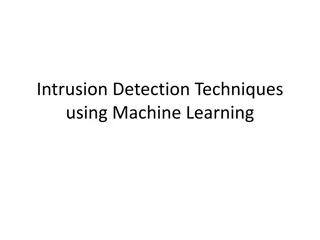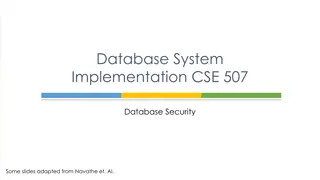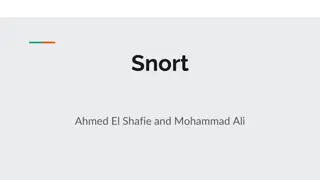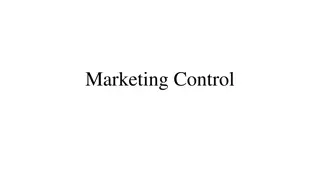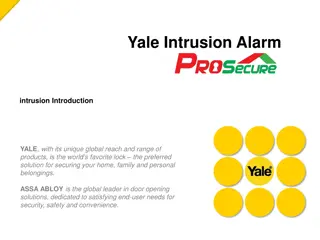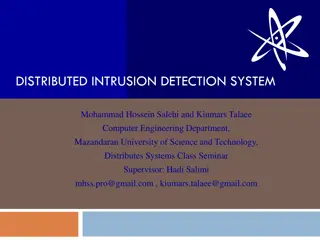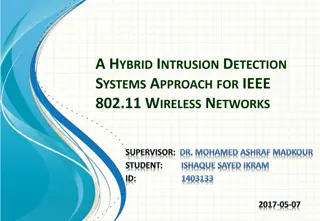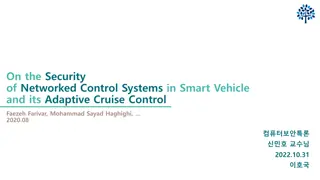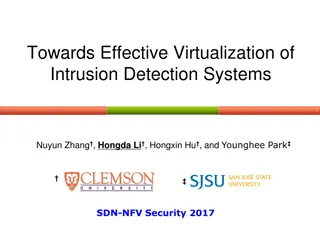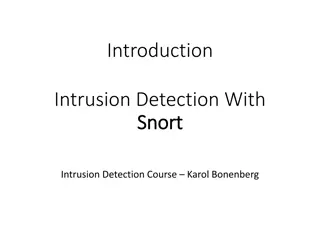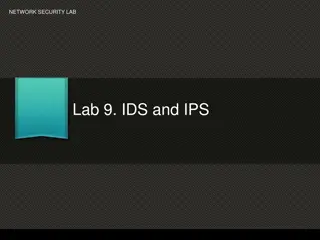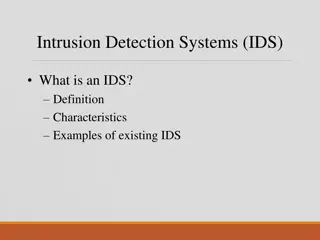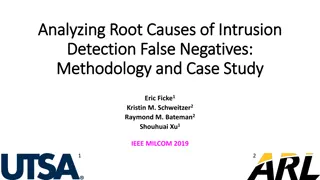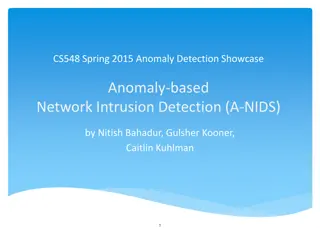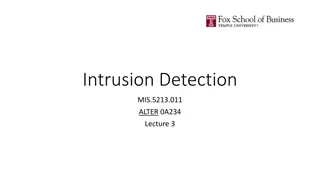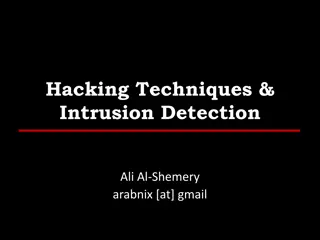
Access Control Mechanisms in System Security
Learn about the two ways a system can protect itself through access control mechanisms, the primary purpose of controlling access to resources, and the importance of access control policies in maintaining system security. Explore identification, authorization, authentication methods, and different access control models like DAC, MAC, and RBAC.
Download Presentation

Please find below an Image/Link to download the presentation.
The content on the website is provided AS IS for your information and personal use only. It may not be sold, licensed, or shared on other websites without obtaining consent from the author. If you encounter any issues during the download, it is possible that the publisher has removed the file from their server.
You are allowed to download the files provided on this website for personal or commercial use, subject to the condition that they are used lawfully. All files are the property of their respective owners.
The content on the website is provided AS IS for your information and personal use only. It may not be sold, licensed, or shared on other websites without obtaining consent from the author.
E N D
Presentation Transcript
A system can protect itself in two ways: It can limit who can access the system. This requires the system to implement a two-step process of identification (asking you who you are) and authentication (asking you to prove it) It can limit what user can do after they have accessed the system.This requires the system to implement access control mechanisms. 3
The primary purpose control access Resources: database records. primary purpose of security mechanisms in a system is to control access to resources. Resources: Files, memory areas, processor time, devices, Some history . . . Some history . . . Early systems had no internal access control. Any user could access any file simply by knowing its name. Access control became a more serious issue with the emergence of disk storage, on which les of many users could be stored (before the days of network and interactive computing). 5
An access control policy -what - by access control policy dictates what types of access - - under what circumstances, by whom types of access are permitted, under what circumstances, and whom. Vital for security Vital for security in operating systems 6
Identification. Identification. { {eg eg: username, account number } : username, account number } Authorization. Authorization. { {eg eg: : pwds pwds, pin , pin nos nos, tokens } , tokens } Authentication. Authentication. {digital signature, fingerprint } {digital signature, fingerprint } 7
Discretionary Mandatory Role Discretionary access control (DAC) Mandatory access control (MAC) Role- -based access control (DAC) access control (MAC) based access control (RBAC) access control (RBAC) 8
Controls access - the identity - on access stating what requestors are (or are not) allowed to do. Controls access based on identity of of the requestor access rules the requestor and rules (authorizations authorizations) This policy is termed discretionary discretionary because: access rights that entity, by its own volition, , to enable another entity to access an permit to enable another entity to access some resource an entity permit the entity might have access rights the entity resource. . 9
What is DAC ? What is DAC ? Why is DAC needed ? Why is DAC needed ? Where it is used ? Where it is used ? How is DAC implemented..? How is DAC implemented..? Advantages of DAC ? Advantages of DAC ? Disadvantages of DAC ? Disadvantages of DAC ? 10
(DAC) is a policy owner of an object. Discretionary access control determined by the owner Discretionary access control (DAC) The owner the object, and what privileges they have. owner decides who is allowed to access 11
--File and data ownership an owner. In most DAC systems, each object's initial owner is the subject that caused it to be created. The access policy for an object is determined by its owner. File and data ownership: Every object in the system has --Access rights and permissions: owner can assign to other subjects for specific resources. Access rights and permissions: These are the controls that an 12
In computer security, discretionary access control (DAC) is a type of access control defined by the Trusted Computer System Evaluation Criteria(TCSEC) as : a means of restricting access to objects based on the identity of subjects and/or groups to which they belong. The controls are discretionary in the sense that a subject with a certain access permission is capable of passing that permission (perhaps indirectly) on to any other subject (unless restrained by mandatory access control) . 13
Usually implemented through Access control lists (ACLs) Each resource object on a DAC based system has an Access Control List Control List(ACL) (ACL) associated with it. Access An ACL contains user has permitted access permitted access together with the level of access for each user or group. contains a list of users and groups to which the level of access 14
DAC is typically the default access control mechanism default access control mechanism for most desktop operating systems. desktop operating systems. widely used in commercial commercial and government government sectors. Operating systems must be built differently depending upon whether they are going to provide DAC or any other access functionality. For example, Windows-based platforms provide a DAC access structure. 15
Flexibility Flexibility Simplicity Simplicity Ease of implementation Ease of implementation 16
increases the risk that data will be made accessible to users that should not necessarily be given access. DAC mechanisms fail to recognize a fundamental difference between human users and computer programs. However, DAC is known to be inherently weak for two reasons. 17
First, granting read access is transitive. First, granting read access is transitive. Information can be copied from one object to another; therefore, there is no real assurance on the flow of information in a system. No restrictions apply to the usage of information when the user has received it. Second, DAC policy is vulnerable to Trojan horse attacks; Second, DAC policy is vulnerable to Trojan horse attacks; because programs inherit the identity of the invoking user. because programs inherit the identity of the invoking user. 18
Controls access -comparing (which indicate.. how sensitive or critical system resources are) with (which indicate ..system entities are eligible to access certain resources). Controls access based on comparing security security labels labels security security clearances clearances This policy is termed mandatory an entity may entity mandatory because has clearance to access a resource not, just by its own volition, enable entity to access entity that may not that has enable another another access that that resource resource. 19
WHAT IS MAC ? WHAT IS MAC ? In computer security, mandatory access control (MAC) refers to a type of access control by which the operating system constrains the ability of a subject to access or generally perform some sort of operation on an object or target. MAC takes a hierarchical approach to controlling access to resources. The term mandatory in MAC has acquired a special meaning derived from its use with military systems. MAC means access controls that are mandated by order of a government and so enforcement is supposed to be more imperative than for commercial applications. 20
IDEA OF MAC: A system mechanism (e.g., the operating system) controls access to an object and an individual user cannot alter that access.Neither the subject nor the owner of the object can determine whether access is granted. The system mechanism will check information associated with both the subject and the object to determine whether the subject should access the object. Rules describe the conditions under which access is allowed.Mandatory policies are also called rule-based policies. Under a MAC enforced environment access to all resource objects (such as data files) is controlled by settings defined by the system administrator. As such, all access to resource objects is strictly controlled by the operating system based on system administrator configured settings. 21
GOALS OF MAC : GOALS OF MAC : Preserve confidentiality and integrity of information Prevent some types of Trojan horse attacks Prevent that a user can change security attributes. WHERE IT IS USED ? WHERE IT IS USED ? Systems that implement MAC models are used in highly secured environments, such as military or government organizations and in Defence departments. 22
Controls access - the roles -on rules given roles. Controls access based on roles that users have within the system and rules stating what accesses are allowed to users in 23
Role-based access control (RBAC) models make access decisions based on the rights and permissions assigned to a role or group, not an individual user. In role based systems, users get assigned roles based on their functions in that system. These systems are centrally administered, they are nondiscretionary. An example is a hospital. It is an access policy determined by the system, not the owner. 24
USE AND AVAILABILITY USE AND AVAILABILITY RBAC is a flexible access control technology whose flexibility allows it to implement DACor MAC. used to manage user privileges (computer permissions) within a single system or application. Access under RBAC is based on a user's job function within the organization to which the computer system belongs. used in commercial applications and also in military systems, where multi- level security requirements may also exist. This kind of model is effective in large companies that have high turnover rates because it allows the administrator to simply place new employees into roles instead of creating new permissions for each and every person who joins the company. 25
SECURITY INTRUSION A security event, or a combination of multiple security events,that constitutes a security incident in which an intruder gains, or attempts to gain, access to a system (or system resource) without having authorization to do so. SECURITY INTRUSION INTRUSION DETECTION A security service that monitors and analyzes system events for the purpose of finding, and providing real-time or near real- time warning of, attempts to access system resources in an unauthorized manner. INTRUSION DETECTION 26
Host Monitors the characteristics of a single host and the events occurring within that host for suspicious activity Host- -based IDS: based IDS: Network Monitors network traffic for particular network segments or devices and analyzes network, transport, and application protocols to identify suspicious activity. Network- -based IDS: based IDS: 27
SENSORS responsible for collecting data. The input may be any part of a system that could contain evidence of an intrusion.Types of input include network packets, log files, and system call traces.Sensors collect and forward this information to the analyzer. SENSORS: ANALYZERS receive ip from 1 or more sensors or from other analyzers. responsible for determining if an intrusion has occurred.The o/p of this component indicates that an intrusion has occurred.The output may include evidence supporting the conclusion. ANALYZERS: 28
USER INTERFACE: system or control the behavior of the system. In some systems, the user interface may equate to a manager, director, or console component. USER INTERFACE: The user interface to an IDS enables a user to view output from the 29




